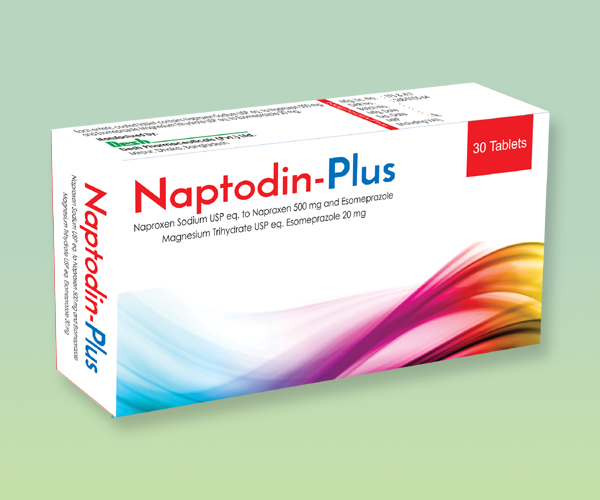Naptodin-Plus
Naproxen Sodium USP
Naptodin-Plus
Naproxen Sodium USP
Naproxen is demonstrated for the alleviation of sign and indications of rheumatoid joint pain, osteoarthritis, ankylosing spondylitis, adolescent joint pain, tendonitis, bursitis & intense gout. It is additionally demonstrated for the administration of essential dysmenorrhea & torment.
- AVAILABILITY: AVAILABLE
Indications
Naproxen is demonstrated for the alleviation of sign and indications of rheumatoid joint pain, osteoarthritis, ankylosing spondylitis, adolescent joint pain, tendonitis, bursitis & intense gout. It is additionally demonstrated for the administration of essential dysmenorrhea & torment.
Pharmacology
Naproxen could be a non steroidal anti-inflammatory sedate (NSAID) with anti-inflammatory, pain relieving & antipyretic properties. It is quickly retained from the gastrointestinal tract and accomplishes 95% bioavailability.
Dosage & Administration
Naproxen Tablet-
- Rheumatoid arthritis, osteoarthritis and ankylosing spondylitis: The usual dose is 500-1000 mg daily in two divided doses after meals.
- Management of pain, primary dysmenorrhea, acute tendonitis & bursitis: Recommended starting dose is 500 mg followed by 500 mg every 12 hours or 250 mg every 6-8 hours. The initial total daily dose should not exceed 1250 mg and thereafter, the total daily dose should not exceed 1000 mg.
- Acute gout: Recommended starting dose is 750 mg followed by 250 mg every 8 hours until the attack has subsided.
Naproxen Suspension-
- For Juvenile rheumatoid arthritis: The usual dose for children over 2 years is 10 mg/kg/day given as two divided doses at 12-hours intervals. Therapy in children under 2 years of age is not recommended.
Naproxen Gel-
- Is to be applied 2-6 times a day as required and is not recommended for use in children.
Interaction
Expert inhibitors: decrease the antihypertensive impact of Expert inhibitors. Antacids & Sucralfate: delay the assimilation of Naproxen. Aspirin: increment unfavorable effects. Diuretics: decrease the natriuretic impact of Furosemide and Thiazides. Methotrexate: upgrade the harmfulness of Methotrexate. Warfarin: increment the chance of GI bleeding. Selective Serotonin Reuptake Inhibitors (SSRI): increment the chance of GI dying.
Contraindications
Naproxen is contraindicated in patients with known extreme touchiness to Naproxen. It ought to not be given to patients who have experienced asthma, urticaria, or allergic-type responses after taking ibuprofen or other NSAIDs. It is contraindicated for the treatment of perioperative torment within the setting of coronary supply route bypass unite (CABG) surgery.
Side Effects
Most regularly detailed side impacts incorporate following: Gastrointestinal: Acid reflux, stomach torment, sickness, loose bowels, dyspepsia. Central Anxious Framework: Cerebral pain, vertigo, drowsiness. Dermatological: Pruritus (tingling), purpura. Cardiovascular: Edema, palpitation. Others: Visual unsettling influences, hearing unsettling influences.
Pregnancy & Lactation
US FDA pregnancy category of Naproxen is C. So, Naproxen should be avoided in pregnancy & lactation unless the potential benefits to the other outweigh the possible risks to the fetus.
Precautions & Warnings
In patients with epilepsy (avoid if poorly controlled, discontinue if convulsions develop), concurrent electroconvulsive therapy (prolonged seizures reported with fluoxetine), history of mania, cardiac disease, diabetes mellitus, angle-closure glaucoma, concomitant use of drugs that increase bleeding risk, and history of bleeding disorders, SSRIs should be used with caution.
Therapeutic Class
Drugs for Osteoarthritis, Drugs used for Rheumatoid Arthritis, Non-steroidal Anti-inflammatory Drugs (NSAIDs)
Storage Conditions
Protect from light and moisture by storing below 30°C. Keep the medicine out of children's reach.
